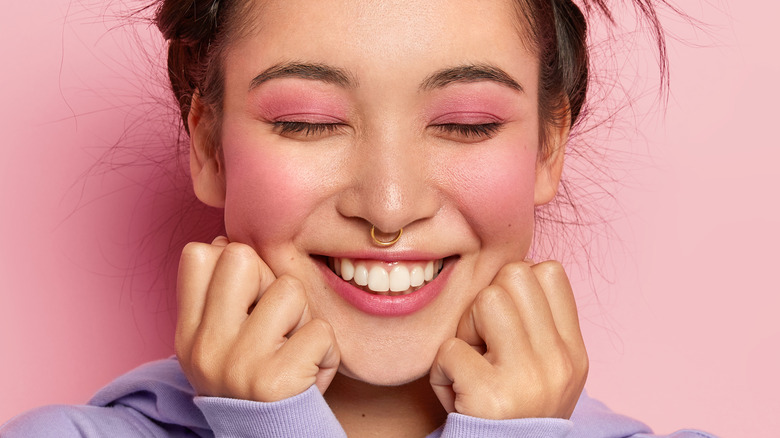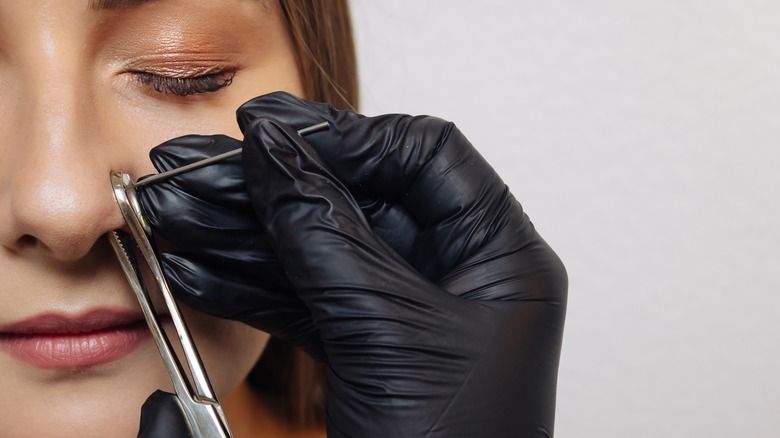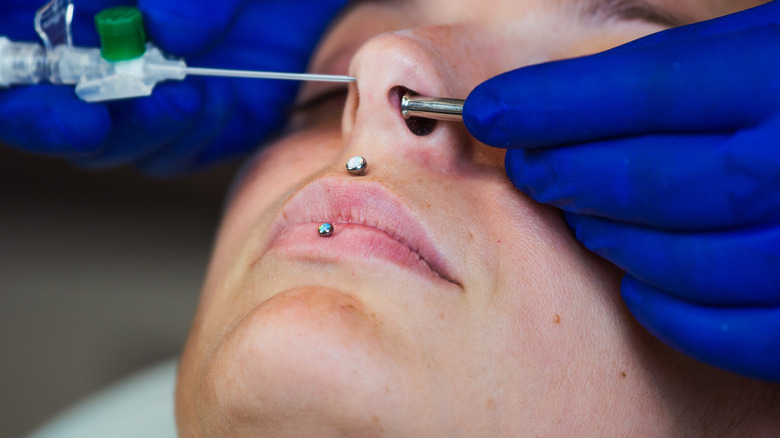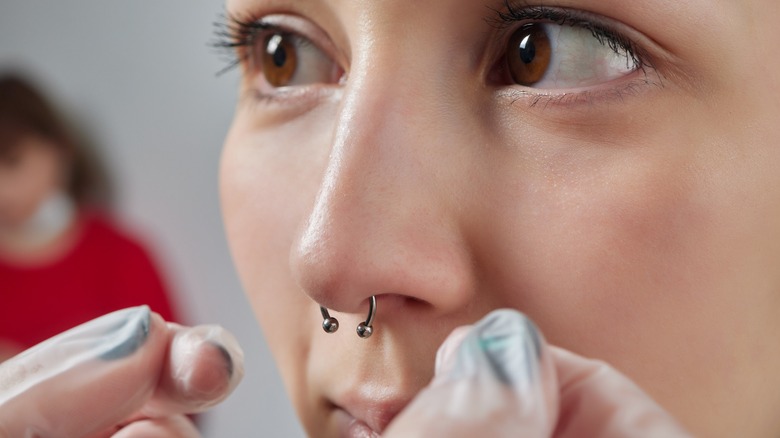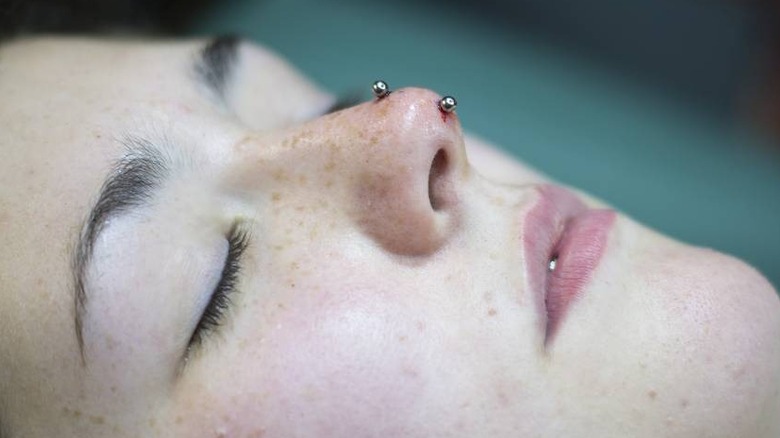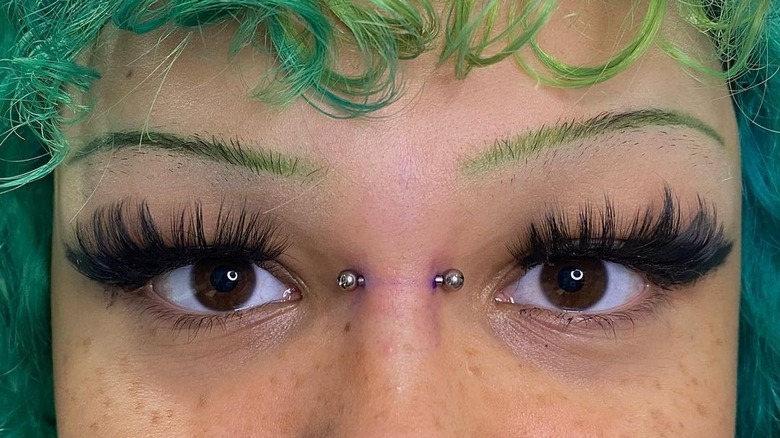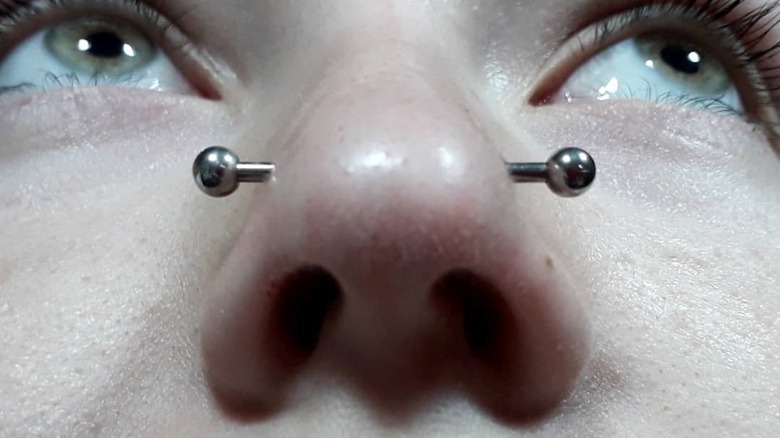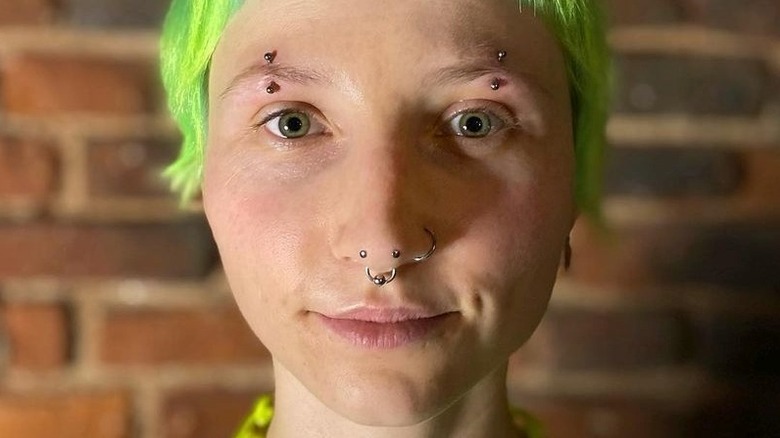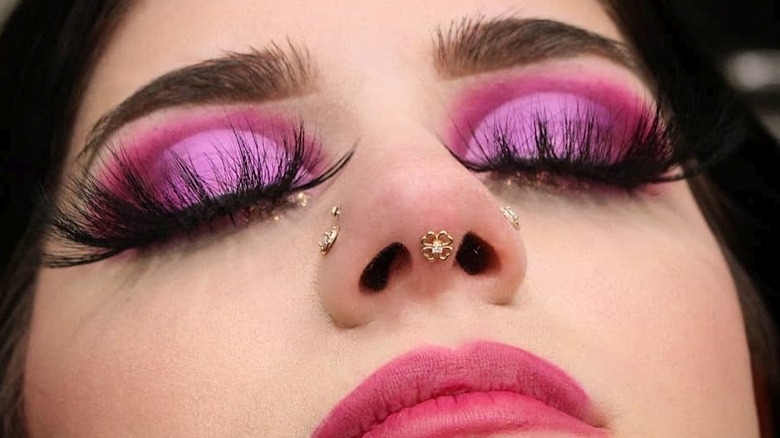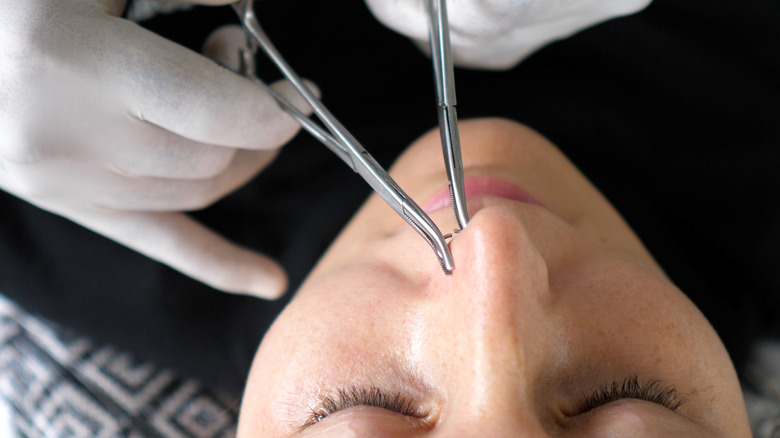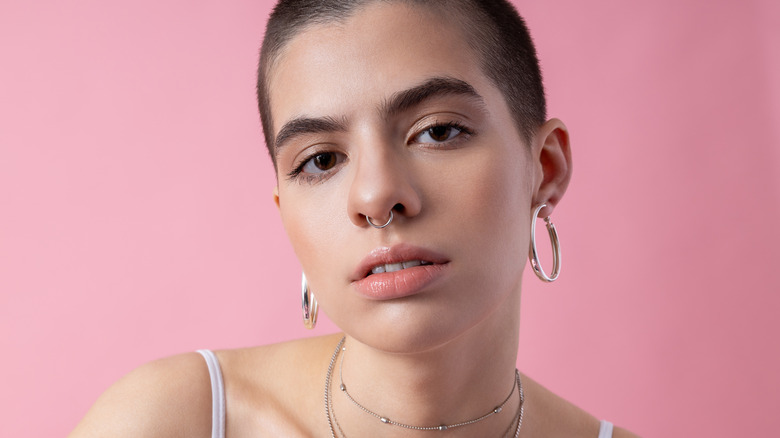How Long Does It Take For A Nose Piercing To Heal?
Body piercings, like makeup and fashion, are a terrific way to brandish one's aesthetic sense. Earrings, whether worn on the lips, nose, or ears, can significantly amplify your personal style. Due to their affordability and low risks, piercings are widely popular among both adults and children. In technical terms, a piercing is the process of making a hole in the body so that jewelry can protrude through it, per MedlinePlus. Most of the time, this treatment is carried out without anesthetic using a piercing gun or a needle (via Tat Ring).
Although both soft and hard tissue piercings are typically safe, infections and allergic reactions can occur. It usually takes one to two months for an earlobe piercing on the soft tissue to heal, per Healthline. Cartilage piercing on hard tissues, like the nose or the outer rims of the ears, might heal differently. According to FreshTrends, the piercing of the nose might be more painful than piercing softer skin, such as the earlobe, because the nose is more sensitive than other parts of the face. But do nose piercings take longer to heal than earlobe piercings? Let's find out.
Types of nose piercings
According to Spencer's, there are various types of nose piercings. They include the Austin Bar piercing, high nostril piercing, multiple nostril piercing, nasallang piercing, rhino piercing, and septum piercing. If you want a nose piercing, you must know on which part of your nose you'd like the ring, bar, or stud. Usually, your piercer would place a small dot on your nose to show where they're going to insert the needle, and you decide if that location suits. It can be a nostril piercing that sits on either side of your nose, an Austin Bar piercing located on the tip of your nose, or a septum piercing placed through the cartilaginous wall between the nostrils. If you have a high tolerance for pain, go for a nasallang piercing, which runs through one nostril to the septum and then out on the other side of the other nostril.
Nose piercings are quick and not too painful if they're placed correctly, piercer Sam Hayler tells PopSugar. "However they might make your eyes water slightly or sneeze as you'll have the inside of your nose tickled!" The healing time for each piercing type is different. A majority of nose piercings heal within one to three months. However, a multiple nostril piercing, which is a combination of the nostril and high nostril piercings performed with a piercing needle, takes six to nine months to heal. While body piercings are generally safe, they are not without potential negative effects.
Health concerns related to a nose piercing
Your nose is located within the danger triangle of your face, which includes the area from the corners of your lips to the bridge of your nose, per Dr. Jennifer Levine, a New York-based facial plastic surgery and beauty procedures practice. This area is linked through blood vessels to the sinus cavity, making infections more likely to spread and worsen quickly. For instance, a popped pimple or a skin cut within that region can cause bacteria to penetrate your skin instantaneously and cause infections. Allergies, excessive bleeding, scarring, and nerve damage are a few uncommon but potential side effects of nose piercings (via WebMD). To minimize health risks, don't get your nose pierced by someone who isn't licensed, neglects sanitary requirements, or uses jewelry that hasn't been sterilized in an autoclave machine. As part of a body piercing treatment, your nose should be disinfected with an antiseptic liquid before it's pierced, and you should be given aftercare tips afterward.
After having your nose pierced, refrain from engaging in physical activities such as swimming and playing contact sports until your wound heals, Medical Piercing advises. Following a recent nose piercing, you should avoid using makeup and touching your nose, because doing so might accidentally cause you to snag the ring out and increase the risk of infection.
Nostril
Nostril piercings are pretty straightforward — they sit on the edge of each nostril. Another variant is the double nostril piercing, which consists of two piercings placed side-by-side on either nostril. According to Authority Tattoo, nostril piercings can heal in two to six months, depending on various factors. Choosing thicker jewelry for your nostril piercing may extend the healing process, and complications can also cause delays. Those with new nostril piercings can change their jewelry by the three-month mark or once the piercing has fully healed. There are many types of jewelry available for nostril piercings, but you should never use a regular earring as a substitute for a nose stud. Earring jewelry used in a nostril piercing can lead to impaired healing, migration, and irritation.
To clean the inside of your nostril piercing, use a cotton swab soaked in warm sea salt solution and allow any buildup to soften. Alternatively, you can dip your nose in sea salt solution and gently exhale to release the debris.
Septum
Septum piercings are the best choice of nose piercing for those who want to avoid a visible scar. Another quirk of septum piercings? After they've fully healed, one can easily conceal the piercing by flipping the jewelry upward. "There's something very pleasingly symmetrical about it. It's also versatile. You can flip it up and hide it, or you can wear something really noticeable," septum fan Steven Wakabayashi told The New York Times. There are various choices when it comes to septum jewelry, from simple, solid rings to elaborate filigree clickers.
The septum is pierced inside of the columella — the fleshy, center portion of your nose that divides your nostrils. However, inexperienced piercers may mistakenly place the piercing on the cartilage, which can negatively impact the rate of healing. Done correctly, a septum piercing should heal within three to four months. By six to eight months post-piercing, you'll be ready to change your original septum piercing jewelry out for alternate options.
Rhino
Just like a real rhinoceros horn, the rhino piercing is located at the tip of one's nose. Because this vertical piercing passes through dense nasal cartilage, it's important to know that it can leave behind noticeable scarring if you choose to remove it. Rhino piercings are relatively uncommon piercings by today's standards, and some piercers may not feel comfortable executing them. "A lot of piercers I've met have never attempted [rhino piercings]," one piercing artist wrote on Reddit. Use your best judgment when evaluating potential piercers, and be sure to ask them about their level of experience with rhino piercings.
Not only are rhino piercings one of the riskiest nose piercings, but they also have a reputation for being rather painful. Furthermore, rhino piercings require a significantly longer healing period than other nose piercings. Although many rhino piercings heal within six months to a year, some can take even longer.
Bridge
Bridge piercings are a type of surface piercing that sits atop the bridge of one's nose, hence their name. Surface piercings can be trickier than standard nose piercings, as they have a higher risk of rejection, according to Fresh Trends. Some signs of a rejected bridge piercing or infection include redness, swelling, and peeling or flaking skin. "Bridges are notoriously finicky. A piercer should tell you what to expect — but expect it to flare up and go down again multiple times," one piercing fan wrote on Reddit. With proper aftercare, most bridge piercings heal fully between four to six months.
Unlike other nose piercings, bridge piercings are best suited to a single type of jewelry: the straight barbell. Fortunately, bridge wearers can choose from an assortment of colors, finishes, and even decorative chains to enhance their piercings. You can gently clean bridge piercings with cotton pads or swabs dipped in saline solution — just be sure to avoid using cotton balls, as their fibers can get caught in your piercing.
Nasallang
The nasallang is a rarer nose piercing variation that looks similar to a double nostril piercing at first glance. That said, it's far more complex than a nostril piercing in terms of its inner anatomy. "A nasallang piercing is a single bar placed through the right nostril, the septum, and the left nostril," piercer Courtney Morrison tells Byrdie.
Due to the amount of cartilage contact involved in the nasallang piercing, the healing process can take at least four to six months, per Healthline. Nasallang piercings are considered one of the most painful piercings, nasal or otherwise, and they're especially prone to developing scar tissue. In fact, many professional piercers avoid nasallang piercings and promote double nostril piercings as a safer alternative. "I always talk my clients out of [nasallang piercings] unless they really want it," one piercer wrote on Reddit. Perhaps the biggest advantage of the nasallang is the ability to say you've endured it.
Austin bar
While it might sound like a Texan drinking establishment, the Austin bar is actually a horizontal piercing placed through the tip of one's nose. Austin bar piercings use straight barbell jewelry and look a bit like the nasallang piercing. The Austin bar's dual-tipped jewelry also closely resembles the mantis piercing, another unusual nasal piercing. However, Austin bar piercings are pretty hard to spot in the wild. Austin bar piercings can be quite painful and may lead to excessive scarring or keloids. Therefore, few people pursue them as their nose piercing of choice, and some piercers may suggest the near-identical mantis piercing as an alternative.
If you're interested in obtaining an Austin bar piercing, make sure to find a reputable piercer for the job. As Austin bar piercings are uncommon and require intimate knowledge of nasal anatomy, you'll need a piercer who has significant experience performing these nose piercings.
Septril
You've heard of the rhino piercing and septum piercing, but what about the septril piercing? Although it shares characteristics with rhino and septum piercings, this piercing has some notable quirks. Septril piercings are inserted through the nasal septum and usually sit just beneath the tip of one's nose.
A septril piercing is different from your average nose piercing, as it requires some preparations before getting pierced. Before you can get a septril piercing, you'll need your septum pierced and stretched. Of course, stretching your septum is no joke – it can take over a year before it's ready to be pierced for your septril, according to All Things Jewelry. That said, the septril is recommended for those with higher pain tolerances and previous piercing experience. The stretching process is demanding, and a pierced septril can take nearly a year to heal fully.
Keep in mind that a stretched septum can also lead to nasal irritation down the road, especially for those with allergies. "The worst part of a large septum is the spontaneous nose running. It constantly drips," one septum wearer wrote on Reddit.
The four stages of healing: hemostasis, inflammatory, proliferation, maturation
In essence, piercings are wounds that go through four stages of healing: hemostasis, inflammation, proliferation, and maturation. Nasal piercings can affect the cartilage or fleshy portion of the nose, but they all heal the same way. First, blood cell pieces known as platelets will clot to seal the piercing in a process called hemostasis. At the same time, your piercing will likely begin to show some signs of redness and swelling. According to research published in The International Journal of Inflammation, this type of response is normal and is known as the inflammatory phase.
After the initial swelling has gone down, your piercing enters the proliferative phase. The proliferative phase kicks in soon after you get pierced, and it can take over a month to run its course. During the proliferative phase, your body produces collagen to reinforce the tissue around your piercing, and swelling begins to go down. By month two, you'll enter the remodeling phase, which allows the skin of your piercing to mature and settle. Depending on the complexity of the piercing involved, the remodeling phase can last from several months to two years, per Rogue Piercing.
How to properly clean a nose piercing
Your piercer should provide you with detailed aftercare instructions and suggestions for cleaning your nose piercing. However, there are some general guidelines that you can follow if you get stuck. Many piercing enthusiasts swear by piercing aftercare or wound sprays. Most aftercare sprays are a balanced mixture of purified water and salt, but some products, like H2Ocean, utilize mineral-dense salts such as red sea salt. Whatever you do, steer clear of harsh ingredients like hydrogen peroxide or rubbing alcohol, as they can impede the healing process.
To clean your nose piercing, saturate a clean cotton swab or paper towel with aftercare solution and gently cleanse the affected area. If you're having difficulty with the cleaning process, try using a mist or spray instead, like NeilMed's Piercing Aftercare Fine Mist. In a pinch, you can place your nose directly into a bowl of warm salt water to soak your piercing.
Signs of infection
No one wants to deal with an infected nose piercing, but how can you tell if your piercing is just swollen or infected? "Any reputable piercer will take a look at your piercing and set your mind at ease. Never panic — worst case, we just remove the jewelry. Your piercer should be your first stop if you are the slightest bit worried, no one else," piercer J. Colby Smith tells Elle. Signs of infection can include pain, discharge or bleeding, and increased swelling. While a healthy, swollen piercing may feel tender or sensitive, an infected piercing can feel hot to the touch. Infected piercings may even cause your lymph nodes to swell or make you feel achy or weak.
In order to treat an infected nose piercing, you must consult with your piercer or doctor before turning to at-home solutions. Don't take out your piercing jewelry unless directed to do so, as this can close the wound and worsen the infection. Your doctor will likely prescribe you antibiotics, which are necessary to prevent serious complications. Once the infection fully heals, there's nothing stopping you from trying a new piercing trend — just make sure to get your piercer's approval first.
